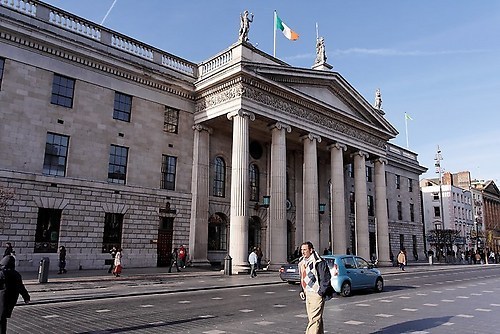
This year’s card is an attempt at representing how its message could be created as a text message on a mobile telephone. (That’s “cell phone” for my US readers.) The symbols on the card represent the individual keystrokes required to generate the characters of the message.
Each key on a telephone keypad represents a number of characters, and there are two ways of selecting which character any keystroke should indicate. In “standard text input” mode, repeatedly pressing a key cycles through the characters that it variously represents. For example, the “2” key is also used for the letters a, b, and c: pressing it once produces “a”, twice “b”, three times “c”, and four times “2”. Some telephones also provide “predictive text input” mode, where the appropriate key is pressed only once for each character and the instrument guesses the meaning of a sequence of keystrokes by comparing them with a dictionary of common words. Predictive text input mode has not been imitated here, as it would have led to a result too short to be interesting.
The basic characters produced by the keys in sequence in standard text mode (sometimes followed by accented characters and other symbols) are:
2 a b c 2
3 d e f 3
4 g h i 4
5 j k l 5
6 m n o 6
7 p q r s 7
8 t u v 8
9 w x y z 9
Once the desired character is formed, if the next character is created from a different key, the cursor automatically moves and a new character is begun. This cannot happen automatically, however, if the new character happens to be formed by pressing the same key as the previous character. In this case, there needs to be some explicit way of indicating that the first character is complete and moving the cursor to begin a new character. There are unfortunately considerable detail differences between telephone models. Thanks to Jane Williams for the loan of her Philips model for experimentation. The sequence used follows that model and assumes that:
Front page
4427#79991
222^44777444777786277771
This translates as:
44 H
2 a
7 p
#7 p
999 y
1
222^ C
44 h
777 r
444 i
7777 s
8 t
6 m
2 a
7777 s
1
and produces:
Happy
Christmas
Inside page
26631223377778194447777443377771
333666777122220#033331333777666#61
22^777444266122^27775533777
This translates as:
2 a
66 n
3 d
1
22 b
33 e
7777 s
8 t
1
9 w
444 i
7777 s
44 h
33 e
7777 s
1
333 f
666 o
777 r
1
2222 2
0 0
#0 0
3333 3
1
333 f
777 r
666 o
#6 m
1
22^ B
777 r
444 i
2 a
66 n
1
22^ B
2 a
777 r
55 k
33 e
777 r
and produces:
and best wishes
for 2003 from
Brian Barker
Once again, I couldn’t resist the cheap air fares to Dublin and spent a couple of days there before Christmas. (If you time it right – which I didn’t quite this time – you can get there for nothing, except the fees and taxes. And it turns out not so cheap if they cancel the coach from Victoria and the airline closes the flight early!) So those cards which I posted were mostly dispatched (using An Post’s special booklet of self-adhesive Christmas stamps) at the GPO in O’Connell Street (below), famous for being the centre of the Easter Rising of 1916. It was burnt out but later rebuilt.

The street outside the post office has undergone changes. The Anna Livia Millennium (er, to Dubliners that’s 1988) Fountain (a female figure reclining in a fountain and generally known as “The Floozy in the Jacuzzi”) seems to have disappeared as fast as it arrived, and the 120-metre Spire of Dublin (“The Spike”) has now taken its place. Indeed, the first twenty metres appeared overnight whilst I was there, with the help of a seriously large crane.
Version 15: Revised 20 December 2024
Brian Barker